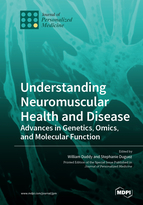Understanding Neuromuscular Health and Disease: Advances in Genetics, Omics, and Molecular Function
A special issue of Journal of Personalized Medicine (ISSN 2075-4426). This special issue belongs to the section "Omics/Informatics".
Deadline for manuscript submissions: closed (31 October 2020) | Viewed by 79496
Special Issue Editors
Interests: stratified medicine; neuromuscular disease; systems biology; integrative bioinformatics
Special Issues, Collections and Topics in MDPI journals
Interests: neuromuscular disorders; motor neuron diseases; extracellular vesicles; mitochondrial biogenesis; muscle ageing; myoblasts; DNA methylation; Duchenne-Becker; amyotrophic lateral sclerosis (ALS); spino-bulbar muscular atrophy (SBMA); spinal muscular atrophy (SMA)
Special Issues, Collections and Topics in MDPI journals
Special Issue Information
Dear Colleagues,
Special Issue “Understanding Neuromuscular Health and Disease: Advances in Genetics, Omics, and Molecular Function” will focus on recent advances in the molecular and cellular understanding of neuromuscular biology, and the treatment of neuromuscular disease. These advances are at the forefront of modern molecular methodologies, often integrating across wet-lab cell and tissue models, dry-lab computational approaches, and clinical studies. The continuing development and application of multiomics methods offer particular challenges and opportunities in the field, not least in the potential for personalized medicine.
We invite researchers in the field to submit original research and review articles on neuromuscular health and disease, including (but not limited to) studies on molecular and cellular mechanisms, molecular functional studies, personalized and precision medicine, genomics and genetic understanding, functional genomics and the application of omics technologies, secretomes and vesicular pathways, system biology, bioinformatics and integrative computational approaches, biomarker discovery and validation, and neuromuscular/musculoskeletal disease models. In addition, studies involving therapeutic approaches, such as antisense mutation-based, or gene and molecular therapy will be considered.
Dr. William Duddy
Dr. Stephanie Duguez
Guest Editors
Manuscript Submission Information
Manuscripts should be submitted online at www.mdpi.com by registering and logging in to this website. Once you are registered, click here to go to the submission form. Manuscripts can be submitted until the deadline. All submissions that pass pre-check are peer-reviewed. Accepted papers will be published continuously in the journal (as soon as accepted) and will be listed together on the special issue website. Research articles, review articles as well as short communications are invited. For planned papers, a title and short abstract (about 100 words) can be sent to the Editorial Office for announcement on this website.
Submitted manuscripts should not have been published previously, nor be under consideration for publication elsewhere (except conference proceedings papers). All manuscripts are thoroughly refereed through a single-blind peer-review process. A guide for authors and other relevant information for submission of manuscripts is available on the Instructions for Authors page. Journal of Personalized Medicine is an international peer-reviewed open access monthly journal published by MDPI.
Please visit the Instructions for Authors page before submitting a manuscript. The Article Processing Charge (APC) for publication in this open access journal is 2600 CHF (Swiss Francs). Submitted papers should be well formatted and use good English. Authors may use MDPI's English editing service prior to publication or during author revisions.
Keywords
- Neuromuscular/musculoskeletal health and disease
- Functional genomics
- Gene therapy
- Molecular biology
- Omics
- Muscular dystrophy
- Duchenne/Becker muscular dystrophy
- Motor neurone disease (MND)/Amyotrophic lateral sclerosis (ALS)
- Biomarkers








